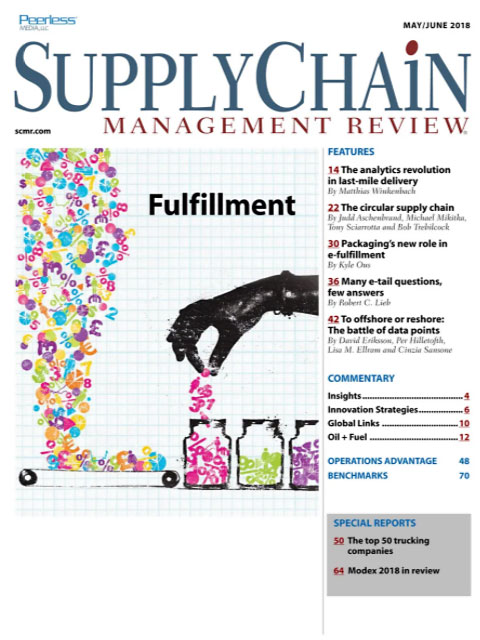Sorry, but your login has failed. Please recheck your login information and resubmit. If your subscription has expired, renew here.
May-June 2018
Last month, I was in Atlanta at the Modex trade show. In one sense, it is a tribute to the automation technologies managing today’s distribution networks. And, I’m not only talking about automated materials handling systems, but also the software and NextGen technologies such as robotics, wearable technologies, including smart glasses and augmented reality solutions and sensors enabling the Internet of Things. In another sense, all of these solutions are coming together to drive fulfillment. With the increase in e-commerce, getting the right product to the right customer at the right time has never been more important. Browse this issue archive.Need Help? Contact customer service 847-559-7581 More options
The lion’s share of demand forecasting publications deal with consumer products and therefore focus more on forecasting demand impacts from the promotional and new product activities of marketing organizations, with less focus on those of the sales organization. In contrast, sales organizations of industrial product companies typically play the most important role in creating and shaping demand—because customers are largely businesses to which they directly sell. I must admit that most of my forecasting publications have been consumer products oriented. Yet, my first major project at a product company, Data General (DG), led to the development of a model to forecast computer revenues based on sales force size and other characteristics.
Sales forecasting at a computer manufacturer
I joined DG, a Fortune 500 industrial products manufacturer of minicomputers, in the early 1980s as a management science analyst in an internal consulting group. The group did in-house analytical projects for various departments within the company. I looked to do my first project with the commercial side of the company, in one of the sales or marketing organizations. A sales support director was my first client at DG, and he was interested in analyzing sales force productivity.
We started the project by collecting data on sales reps and how much they sold each fiscal quarter, as well as other information about them. After much data crunching, we uncovered a correlation between the amount of time a sales rep was with the company and his/her sales performance—a “learning curve” per se. For example, we found that newly hired sales reps sold very little in their first six months at the company. It turned out there was a steep learning curve to selling computers. As a rapidly growing high-tech company with significant sales rep turnover, many of our reps in our “hot” sales markets were fairly new to the company.

This complete article is available to subscribers only.
Log in now for full access or start your PLUS+ subscription for instant access.
SC
MR
Sorry, but your login has failed. Please recheck your login information and resubmit. If your subscription has expired, renew here.
May-June 2018
Last month, I was in Atlanta at the Modex trade show. In one sense, it is a tribute to the automation technologies managing today’s distribution networks. And, I’m not only talking about automated materials… Browse this issue archive. Access your online digital edition. Download a PDF file of the May-June 2018 issue.The lion's share of demand forecasting publications deal with consumer products and therefore focus more on forecasting demand impacts from the promotional and new product activities of marketing organizations, with less focus on those of the sales organization. In contrast, sales organizations of industrial product companies typically play the most important role in creating and shaping demand—because customers are largely businesses to which they directly sell. I must admit that most of my forecasting publications have been consumer products oriented. Yet, my first major project at a product company, Data General (DG), led to the development of a model to forecast computer revenues based on sales force size and other characteristics.
Sales forecasting at a computer manufacturer
I joined DG, a Fortune 500 industrial products manufacturer of minicomputers, in the early 1980s as a management science analyst in an internal consulting group. The group did in-house analytical projects for various departments within the company. I looked to do my first project with the commercial side of the company, in one of the sales or marketing organizations. A sales support director was my first client at DG, and he was interested in analyzing sales force productivity.
We started the project by collecting data on sales reps and how much they sold each fiscal quarter, as well as other information about them. After much data crunching, we uncovered a correlation between the amount of time a sales rep was with the company and his/her sales performance—a “learning curve” per se. For example, we found that newly hired sales reps sold very little in their first six months at the company. It turned out there was a steep learning curve to selling computers. As a rapidly growing high-tech company with significant sales rep turnover, many of our reps in our “hot” sales markets were fairly new to the company.
SC
MR


Latest Supply Chain News
- Despite American political environment, global geopolitical risks may be easing
- Joseph Esteves named CEO of SGS Maine Pointe
- Employees, employers hold divergent views on upskilling the workforce
- April manufacturing output slides after growing in March
- Q1 sees a solid finish with positive U.S.-bound import growth, notes S&P Global Market Intelligence
- More News
Latest Podcast

 Explore
Explore
Business Management News
- Joseph Esteves named CEO of SGS Maine Pointe
- Employees, employers hold divergent views on upskilling the workforce
- April manufacturing output slides after growing in March
- Q1 sees a solid finish with positive U.S.-bound import growth, notes S&P Global Market Intelligence
- 6 Questions With … Sandeep Bhide
- MIT CTL offering humanitarian logistics course
- More Business Management
Latest Business Management Resources

Subscribe

Supply Chain Management Review delivers the best industry content.

Editors’ Picks





